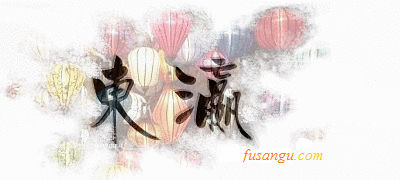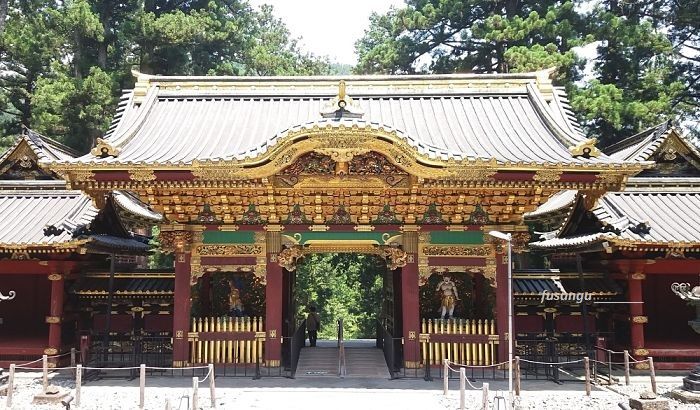
Having only one week at your disposal means you will have to renounce to many destinations. A very reasonable choice is to stick to a classic Tokyo - Kyoto route. Along the way you can add a third destination or you can arrange for one or two side trips.
In this page we briefly outline a selection of seven-day itineraries along the Tokyo-Kyoto route.
Contents
-
First journey to Japan (choice of the itinerary, main destinations, side trips)
-
Recommended 7-day itineraries (Kyoto and Tokyo; inclusion of a third major destination, one-day excursions from Tokyo and Kyoto)
-
Where to stay (accommodation in Tokyo, Kyoto, Kanazawa)
Seven days in Japan: choice of the itinerary
A first journey to Japan should include both Tokyo and Kyoto. The two cities are gateways to exploring the modern and traditional culture of the nation and they are undoubtedly the main destinations of any first trip to Japan.
As a week is a very short period of time, you may want to limit your choices to these two destinations and possibly add one or two day-excursions.
Transfers between Tokyo and Kyoto can offer opportunities for short visits along the way. You can easily add a short visit to Kanazawa (most atmospheric in autumn and winter).
Near Kyoto are important destinations such as Nara, Osaka and Mount Koya. Nikko can be visited with a day trip from Tokyo.
Seven days in Japan: recommended itineraries
Tokyo and Kyoto are the two major destination for a 7-day itinerary in Japan. Both cities deserve long stays, ideally of at least 3-4 days. In view of this, we suggest you choose to devote an entire week, 7 days, to these two destinations.
Here are the suggested itineraries:
Itinerary 1: Tokyo, Kyoto with side-trips from both cities;
Itinerary 2: Tokyo, Kanazawa, Kyoto
Itinerary 3: Tokyo and surroundings
Itinerary 4: Kyoto and surroundings
We assume that Narita Airport (near Tokyo) is the point of arrival and departure. Another option is to enter and exit the country through Kansai Airport (near Osaka and Kyoto).
If you travel from Asia you may also consider other points of entry such as the airports of Nagoya and Okayama.
Itinerary 1: Tokyo and Kyoto
If you do not feel comfortable with tight schedules and enjoy slow travelling and the possibility of improvising and letting the journey lead you, you may choose to plan to visit only Tokyo and Kyoto. You can allocate time in many different ways. We suggest spending 3 days in Tokyo and 4 days in Kyoto.
Transfers between the two cities take around 3 hours. Therefore, if you travel in the early morning or late afternoon, you will not waste time.
From both cities you can easily arrange side-trips. All transfers can be made by train or by bus. You can also join group tours, which are getting cheaper and cheaper.
A possible schedule that encompasses two side trips is the following:
-
Day 1: Tokyo; transfer between Narita Airport and Tokyo; visit to Asakusa and Sumida;
-
Day 2: Nikko, excursion from Tokyo; visit to the main shrines and temples (Toshogu, Futarasan-Jinja, Rinno-Ji);
-
Day 3: Tokyo; visit to Ueno, Shibuya and Shinjuku;
-
Day 4: Kyoto; early morning transfer to Kyoto from Tokyo; visit to the city centre, Pontocho and Gion;
-
Day 5: Kyoto; classic Higashiyama and Sakyo itinerary, from Kiyomizu-dera to Ginkaku-ji walking tour (through Sannen-zaka, Ninen-zaka, Maruyama Park, Philosopher’s Path);
-
Day 6: Nara, excursion from Kyoto; visit to the main shrines, temples and gardens in Nara Park (Kofuku-Ji, Isui-En, Todai-Ji, Kasuga Taisha);
-
Day 7: Kyoto; Kinkaku-Ji and Arashiyama (Tenryu-Ji, Bamboo Grove, Gio-Ji, Rakushisha); late afternoon transfer to Tokyo; end of the journey.
How to organise the transfers
If you choose a round trip flight itinerary (entry and exit through the same airport, typically Narita Airport), it would pay off to make use of a 7-day Japan Rail Pass ticket. This has to be activated at the airport of entry, so as to cover all major transfers of the itinerary:
-
Narita Airport-Tokyo (by N’EX, Narita Express)
-
Tokyo-Kyoto (by shinkansen, Hikari)
-
Excursions from Kyoto (such as Kyoto-Osaka, Kyoto-Nara, Kyoto-Himeji)
-
Kyoto-Tokyo (by shinkansen, Hikari)
-
Tokyo-Narita Airport (by N’EX, Narita Express, the fastest option)
If you exit the country from a different airport, typically Osaka, you do not need to buy a JR Pass.
Transfers between Tokyo and Nikko are covered by the JR Pass for travels along the sole JR network. In general a more convenient option is offered by the Nikko World Heritage Pass, which is offered by the private company Tobu.
Itinerary 2: Tokyo, Kanazawa and Kyoto
If you are most interested in Japan’s traditional culture you might want to add a short visit to Kanazawa, a major city located near the western coast. The city boasts a unique historical centre that comprises a few neighbourhoods that retain the beauty and harmony of the traditional architecture. Not to be missed are also the Kenroku-En, a wonderful landscape garden, the Kanazawa-Jo, the city castle, and Nagamachi, the samurai district.
Kanazawa is located in the Chubu Region, which lies between Kanto and Kansai. This means you can visit Kanazawa as an intermediate destination along the journey between Tokyo and Kyoto. Moreover, you can take advantage of a new pass, which covers transfers between Tokyo, Kansai through Hokuriku Region.
You can allocate time in many different ways. We suggest spending 2 and a half days in Tokyo, 1 and a half days in Kanazawa, and 3 days in Kyoto.
As for day-trips, we suggest the following destinations:
-
From Tokyo: Nikko or Kamakura
-
From Kyoto: Nara
How to organise the transfers
If you choose a round trip flight itinerary (entry and exit through the same airport, typically Narita Airport), it would pay off to make use of a 7-day Hokuriku Japan Rail Pass ticket. This is cheaper than the regular 7-day nationwide Japan Rail Pass.
The pass has to be activated on the first day of the journey, so as to cover all major transfers of the itinerary:
-
Narita Airport-Tokyo (by N’EX, Narita Express, the fastest option)
-
Tokyo-Kanazawa (by shinkansen)
-
Kanazawa-Kyoto (by limited express)
-
Excursions from Kyoto (such as Kyoto-Osaka, Kyoto-Nara)
-
Kyoto-Tokyo (by limited express and shinkansen, through Kanazawa)
-
Tokyo-Narita Airport (by N’EX, Narita Express)
The only drawback is that all Tokyo-Kyoto transfers require passing through Kanazawa, which means you cannot travel along the direct Tokyo-Kyoto Tokaido Shinkansen Line. This indirect transfer takes around 5 hours instead of the typical 3 hours of the direct route.
Itinerary 3: Tokyo and surroundings
Tokyo is a small universe where you can find any kind of attractions. The city has something for anyone and while it is often regarded as a symbol for modern Japan, the city has plenty of landmarks and historical sites that will satisfy those who seek the beauty, meaningfulness and harmony of traditional culture.
Not far from Tokyo are also quite a few relatively secluded towns that offer access to beautiful and serene and largely untouched natural landscapes.
As the schedule is tight we suggest considering only the following day-trips:
-
From Tokyo: Nikko, Kamakura, Hakone, Mount Fuji and the Five Lake Region
A possible schedule that encompasses two side trips is the following:
-
Day 1: Tokyo; transfer between Narita Airport and Tokyo; visit to Asakusa (Senso-Ji and its surroundings) and Sumida (Edo-Tokyo Museum, Yokoamicho Memorial Park, Sky Tree Tower);
-
Day 2: Nikko, excursion from Tokyo; visit to Sannai, main shrines and temples (Toshogu, Futarasan-Jinja, Rinno-Ji);
-
Day 3: Tokyo; visit to Ueno (park and one or two museums) and Bunkyo (Koishikawa Koraku-En and Rikugi-En gardens, Tokyo Domu entertainment park, Kodokan Judo Headquarters);
-
Day 4: Tokyo; in spring visit to Minato (Aoyama Cemetery and Roppongi), Shibuya (Nezu Museum, entertainment and commercial district), Harajuku (Meiji-Jingu shrine and Omotesando) Meguro-gawa cherry blossom viewing spot;
-
Day 5: Tokyo; visit to Shinjuku (main museums, Shinjuku-Gyoen National Park, shopping and entertainment area, Tokyo Metropolitan Government Building observation deck); possible addition: Ikebukuro or Ginza;
-
Day 6: Kamakura, excursion from Tokyo; visit to the main shrines and Zen temples in Kamakura and Kita-Kamakura;
-
Day 7: Tokyo; final visit to Akihabara (electric town) and Kanda (ancient temples and shrines, bookshops) or Odaiba (museums and Toyosu Market).
How to organise the transfers
It would not be economical to buy any JR Pass tickets. For transfers within Tokyo you can simply use the subway tickets and day passes. Excursions to Nikko and Kamakura are quite cheap. If you choose to visit Hakone you can take advantage of a specific tourist pass that covers transfers from/to Tokyo and local transportation in Hakone.
For transfers between Narita Airport and Tokyo’s city centre you can opt for solutions by train (the local Sobu Line train offering the cheapest option) of by limousine bus. Another choice is to use the Keisei Main Line, especially convenient if you find a hotel in Asakusa or Ueno.
Itinerary 4: Kyoto and surroundings
The ancient capital of Japan, Kyoto, is a fascinating history and the cultural heart of the nation. Moreover, Kyoto is at the centre of a region which is home to some of Japan’s most sacred sites and many places of historical and artistic interest.
You can easily spend an entire week in Kyoto without getting short of excitement and opportunities to discover something new and inspiring to you.
In addition, there is plenty of choice when it comes to arranging side trips to minor locations, off-the-beaten tracks destinations and scenic places.
If you are into traditional culture we suggest you devote four full days to Kyoto. Other days can be used for side trips. If you are a keen traveller, you may even choose to visit some places for the second time. This is often the case in autumn and spring when nature creates a unique context with foliage and flowering phenomena.
As for the other day-trips, we suggest considering the following destinations:
-
From Kyoto: Nara, Osaka, Himeji, Uji, Mount Koya, Kobe
We assume that you enter and exit the country through Kansai Airport, main hub in the region of Kansai.
A possible schedule that encompasses two side trips is the following:
-
Day 1: Osaka; transfer between Kansai Airport and Osaka; visit to Osaka (Umeda, Osaka Castle, Keitaku-En, Harukasu Tower, Nihombashi and Namba);
-
Day 2: Koyasan, transfer from Osaka, one night in Koyasan; visit to the main shrines, temples;
-
Day 3: Nara, transfer from Koyasan, one night in Nara; visit to the main shrines, temples and gardens in Nara Park (Kofuku-Ji, Isui-En, Todai-Ji, Kasuga Taisha);
-
Day 4: Nara and Kyoto; visit to Naramachi old district; transfer to Kyoto. Visit to Fushimi Inari Taisha. Visit to Kyoto’s city centre (Pontocho and Nishiki Market) and Gion;
-
Day 5: Kyoto; classic Higashiyama and Sakyo itinerary, from Kiyomizu-dera to Ginkaku-ji walking tour (through Sannen-zaka, Ninen-zaka, Maruyama Park, Philosopher’s Path);
-
Day 6: Kyoto; Nijo Castle, Kamishichiken, Kitano Tenmangu shrine and Kinkaku-Ji;
-
Day 7: Kyoto; full day in Arashiyama (Tenryu-Ji, Bamboo Grove, Gio-Ji, Rakushisha, Daikaku-Ji); late afternoon transfer to Osaka; end of the journey.
How to organise the transfers
If you choose a round trip flight itinerary (entry and exit through the same airport, typically Kansai Airport), you do not need to buy any JR Pass tickets.
A good option is to buy the Koyasan World Heritage Pass which covers transfers between Osaka and Koyasan as well as local transportation in Koyasan.
Transfers between Osaka, Nara and Kyoto are very cheap and you can simply use local and express trains. There is no need to buy any discount tickets.
An exception is when you choose to stay in Osaka and visit Kyoto with day trips. This solution is suitable to those who need to cut costs or failed to find any suitable accommodation at affordable tariffs in Kyoto. This circumstance occurs frequently in spring, autumn and during the national holidays.
Related articles:
Itineraries in Japan: 5 days | 10 days | 14 days
First journey to Japan: Ten-day classic itinerary
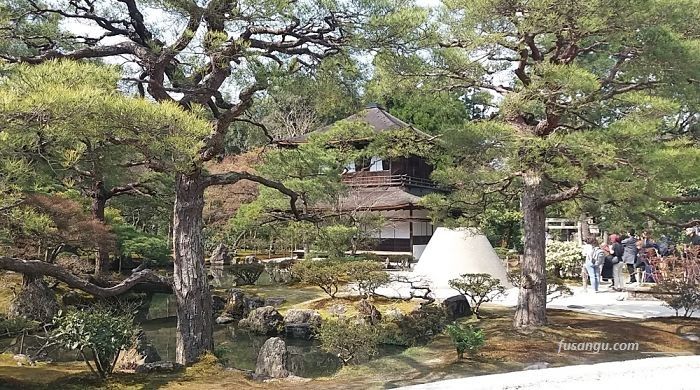
If your journey to Japan can last for only five days your best option is to opt for a classic Tokyo - Kyoto itinerary. Along the way you can add a third destination or you can arrange for one or two day trips from the two cities.
In this page we briefly outline a selection of five-day itineraries along the Tokyo-Kyoto route.
Contents:
-
First journey to Japan (choice of the itinerary, main destinations, side trips)
-
Recommended 5-day itineraries (Kyoto and Tokyo; one-day excursions from Tokyo and Kyoto)
-
Where to stay (accommodation in Tokyo, Kyoto, Osaka)
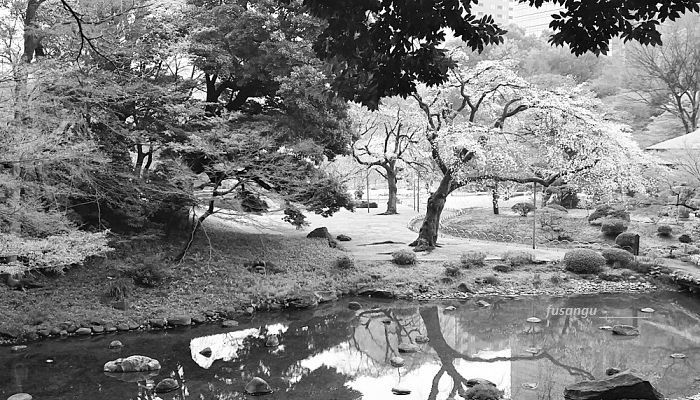
Five days in Japan: choice of the itinerary
A first journey to Japan should include both Tokyo and Kyoto. The two cities are gateways to exploring the modern and traditional culture of the nation and they are undoubtedly the main destinations of any first trip to Japan.
As five days are a very short period of time, you may opt for visiting only Tokyo and Kyoto or only one main destination.
Near Kyoto are important destinations such as Nara, Osaka and Mount Koya while Nikko can be visited with a day trip from Tokyo.
Five days in Japan: recommended itineraries
The key choice for a 5-day itinerary revolves around the question of whether to visit both Tokyo and Kyoto or only one of the two.
Here are the suggested itineraries:
-
Itinerary 1: Tokyo, Kyoto with side trips;
-
Itinerary 2: Tokyo, Kyoto;
-
Itinerary 3: Tokyo and surroundings;
-
Itinerary 4: Kyoto and surroundings.
We assume that Narita Airport (near Tokyo) is the point of arrival and departure. Another option is to enter and exit the country through Kansai Airport (near Osaka and Kyoto).
Itinerary 1: Tokyo and Kyoto with side trips
A good way to arrange a 5-day itinerary is to spend 2 days in Tokyo and 2 days in Kyoto. A full day can be devoted to a side-trip from either Tokyo or Kyoto.
Transfers between the two Tokyo and Kyoto take around 3 hours. Therefore, if you travel in the early morning or late afternoon, you will not waste time.
As for day-trips, we suggest the following destinations:
-
From Tokyo: Nikko, Kamakura or Hakone;
-
From Kyoto: Nara, Osaka or Himeji.
How to organise the transfers
If you choose a round trip flight itinerary (entry and exit through the same airport, typically Narita Airport), these are the major transfers of the journey:
-
Narita Airport-Tokyo (by N’EX, Narita Express);
-
Tokyo-Kyoto (by shinkansen, Hikari);
-
Excursions from Kyoto (such as Kyoto-Osaka, Kyoto-Nara, Kyoto-Himeji);
-
Kyoto-Tokyo (by shinkansen, Hikari);
-
Tokyo-Narita Airport (by N’EX, Narita Express, the fastest option available).
Itinerary 2: Tokyo and Kyoto
A 5-day itinerary through Tokyo and Kyoto can have the following schedule:
-
Day 1: Tokyo; transfer between Narita Airport and Tokyo; visit to Asakusa and Sumida or Bunkyo;
-
Day 2: Tokyo; visit to Ueno, Shibuya and Shinjuku;
-
Day 3: Kyoto; early morning transfer to Kyoto from Tokyo; visit to the city centre, Pontocho and Gion;
-
Day 4: Kyoto; classic Higashiyama and Sakyo itinerary, from Kiyomizu-dera to Ginkaku-ji walking tour (through Sannen-zaka, Ninen-zaka, Maruyama Park, Philosopher’s Path);
-
Day 5: Kyoto; Kinkaku-Ji and Arashiyama (Tenryu-Ji, Bamboo Grove, Gio-Ji, Rakushisha); late afternoon transfer to Tokyo; end of the journey.
How to organise the transfers
Travelling by train is the best option. Night buses offer cheaper solutions.
Itinerary 3: Tokyo and surroundings
Five days can be spent only in Tokyo. You may also add one or two side trips. We suggest considering only the following day-trips:
-
From Tokyo: Nikko, Kamakura.
A possible schedule that encompasses one side trip is the following:
-
Day 1: Tokyo; transfer between Narita Airport and Tokyo; visit to Asakusa (Senso-Ji and its surroundings) and Sumida (Edo-Tokyo Museum, Yokoamicho Memorial Park, Sky Tree Tower);
-
Day 2: Nikko, excursion from Tokyo; visit to Sannai, main shrines and temples (Toshogu, Futarasan-Jinja, Rinno-Ji);
-
Day 3: Tokyo; visit to Ueno (park and one or two museums) and Bunkyo (Koishikawa Koraku-En and Rikugi-En gardens, Tokyo Domu entertainment park, Kodokan Judo Headquarters);
-
Day 4: Tokyo;Shibuya (Nezu Museum, entertainment and commercial district), Harajuku (Meiji-Jingu shrine and Omotesando) and Shinjuku (Shinjuku-Gyoen National Park, shopping and entertainment area, Tokyo Metropolitan Government Building observation deck);
-
Day 5: Tokyo; final visit to Akihabara (electric town) and Kanda (ancient temples and shrines, bookshops) or Odaiba (museums and Toyosu Market).
How to organise the transfers
For transfers within Tokyo you can simply use the subway tickets and day passes. Excursions to Nikko and Kamakura are quite cheap.
Itinerary 4: Kyoto and surroundings
You can easily spend five days in Kyoto without getting short of excitement and opportunities to discover something new and inspiring to you.
As for the possible day-trips, we suggest considering the following destinations:
-
From Kyoto: Nara, Osaka, Himeji, Uji, Mount Koya.
We assume that you enter and exit the country through Kansai Airport, main hub in the region of Kansai.
A possible schedule that encompasses two side trips is the following:
-
Day 1: Osaka; transfer between Kansai Airport and Nara; one night in Nara; visit to the main shrines, temples and gardens in Nara Park (Kofuku-Ji, Isui-En, Todai-Ji, Kasuga Taisha);
-
Day 2: Nara and Kyoto; visit to Naramachi old district; transfer to Kyoto. Visit to Fushimi Inari Taisha. Visit to Kyoto’s city centre (Pontocho and Nishiki Market) and Gion;
-
Day 3: Kyoto; classic Higashiyama and Sakyo itinerary, from Kiyomizu-dera to Ginkaku-ji walking tour (through Sannen-zaka, Ninen-zaka, Maruyama Park, Philosopher’s Path);
-
Day 4: Kyoto; Nijo Castle, Kamishichiken, Kitano Tenmangu shrine and Kinkaku-Ji;
-
Day 5: Kyoto; full day in Arashiyama (Tenryu-Ji, Bamboo Grove, Gio-Ji, Rakushisha, Daikaku-Ji); late afternoon transfer to Osaka; end of the journey.
If you want to visit Mount Koya and spend a night in a monastery you can reduce the number of days spent in Kyoto.
How to organise the transfers
Transfers between Osaka, Nara and Kyoto are very cheap and you can simply use local and express trains. There is no need to buy any discount tickets.
An exception is when you choose to stay in Osaka and visit Kyoto with day trips. This solution is suitable to those who need to cut costs or failed to find any suitable accommodation at affordable tariffs in Kyoto. This circumstance occurs frequently in spring, autumn and during the national holidays.
Where to stay in Tokyo and Kyoto
With such little time available the best choice is to stay in the vicinity of major railway stations or neighbourhoods which are well connected to the subway and railway networks of the city.
Below for each city we give a list of convenient locations.
In Tokyo
The best locations where to find accommodation in Tokyo for a short stay and a typical travel itinerary are the following:
-
1) Tokyo Station: near the city's central stations is a wide range of hotels. Cheap hostels are found in nearby Bakurocho area;
-
2) Asakusa: the city's most prominent tourist area;
-
3) Shinjuku: the centre of Tokyo's vibrant night life.
Cheap mid-range hotels are found also in Sumida, east of Asakusa. You might even choose to stay near Shinagawa Station or any other major station served by the Yamanote loop line.
In Kyoto
The best are where to find accommodation in Kyoto for a short stay are the following:
-
1) Kyoto Station: the centre of the city's mass transit network. The area is reasonably close to the centre;
-
2) Gion: the fascinating historical district, very close to many important sightseeing spots and temples;
-
3) Kamigyo: an authentic neighbourhood, largely remained unaffected by the rise of tourism. This area offers good mid-range local-style accommodation options, varying from traditional ryokan inns to entire houses. Many structures are particularly suitable for families and groups. The area is placid and well connected to the city bus network. Moreover, you can easily get around by bicycle.
In Osaka
The area near Namba Station offers a wide variety of hostels, cheap hotels and a few mid-range hotels. Nearby is Dotombori, a prime night life area. Luxury hotels are in Umeda, near Osaka Station.
Japan Rail Pass (2023 update)
In October 2023 general Japan Rail Pass tickets (all Japan passes) underwent a sharp increase in price. This rendered them not convenient for itineraries like the ones described in this page. Hokuriku Arch Pass tickets, which provide unlimited travelling by train along the Tokyo - Kanazawa - Kyoto route for 7 days are still a good resource to reduce costs.
Related articles:
Itineraries in Japan: 7 days | 10 days | 14 days
First journey to Japan: Ten-day classic itinerary
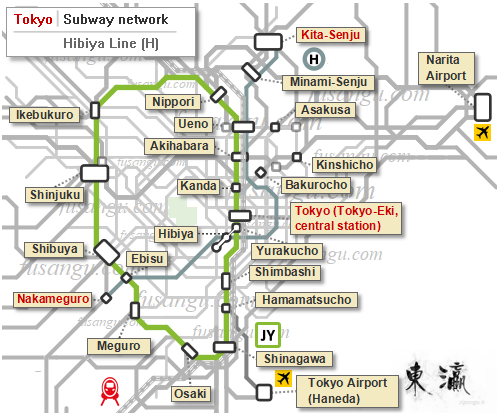
For the purpose of tourism, the Hibiya-sen is among the most useful lines of Tokyo’s subway networks.
The line runs north-south connecting many of the city’s most popular tourist areas such as Ueno, Akihabara, Ginza, Minato, Meguro.
In this page we describe a one-day tour along the Hibiya Line. The article includes a programme suitable for short stays.
The Hibiya Line (Hibiya-sen) is managed by the main subway operator, Tokyo-Metoro.
The line connects many places of interest and serves important stations and transportation hubs.
These are the termini:
-
Minami-Senju, northern terminus, in Arakawa; interchange with Joban Line (JR railway network);
-
Nakameguro, southern terminus, in Meguro.
In the central section, the line runs very close to the Yamanote Line (the railway loop line).
Areas of interest served by the line are the following:
-
Ueno, neighbourhood noted for the prestigious museums and a large park;
-
Akihabara, the “electric town”, a gathering place for otaku and anime and manga buffs;
-
Chuo, central district; the line connects important neighbourhoods, such as Nihombashi and Ginza;
-
Roppongi, a district known for modern art museums, upscale shopping malls and a cosmopolitan night life;
-
Nakameguro, one of Tokyo’s top cherry blossom viewing spots.
It is not possible to visit all these areas in one day, especially if you wish to include visits to museums in your programme.
Recommended itinerary along the Hibiya Line
Below is the outline of a programme that suits well the needs of a first-time visitor. We assume you start your journey in Ueno:
-
8:30 - 12:00: visit to Ueno. Here you can visit Tokyo National Museum and Ueno Park. Not to be missed are Toshogu Shrine and Benten-Do, beautiful religious architectures peacefully set amid the serenity of the park;
-
12:30 - 16:00: lunch break and visit to Akihabara, a little dreamland for those who love anime, manga, cosplay and electronics;
-
16:15 - 18:30: walking tour in Ginza. Aside from the glittering shopping malls, the neighbourhood offers a few traditional shops that preserve traditional productions. Among the products are kimono, Japanese paper, furniture and much more. There are also quite a few small shrines and a large Buddhist temple built in a unusual style, reminiscent of Indian art, Hongwan-Ji Temple.
In the evening
You can conclude your tour in many ways, among which:
-
Clubbing in Roppongi, an area that have catered to foreigners for long time;
-
Viewing cherry blossom in Nakameguro, the area is lit at night in the flowering season;
-
Having dinner in an izakaya near Akihabara, a simple and cheerful way of exploring the ordinary lifestyle of the locals.
Many other choices are possible. Near Roppongi is another cherry blossom spot, Sakura-Koen. Not far are Aoyama Cemetery and Nezu Museum, a great destination for those who are interested in East Asian ancient art and culture.
Near Nakameguro are the Museum of Parassitology and a few temples.
Where to stay
Ueno is served by the Hibiya Line and is a prime choice for lodging. Staying in Ueno allows for easy transfers to the airports, the shinkansen railway stations and every major area of Tokyo.
If you choose to stay in Ueno, you have to book well in advance as most hotels and hostels are quickly sold out.
North of Ueno, around Iriya Station are a few cheap hotels and hostels. Even better to those who travel on a budget is to look for a place to stay in the vicinity of Minami-Senju Station.
Related articles:
Main article: Tokyo 3-day itinerary
Itineraries along the subway lines (Asakusa, Hibiya, Ginza, Marunouchi, Tozai, Mita, Namboku, Yurakucho, Chiyoda, Shinjuku, Hanzomon, Oedo, Fukutoshin)
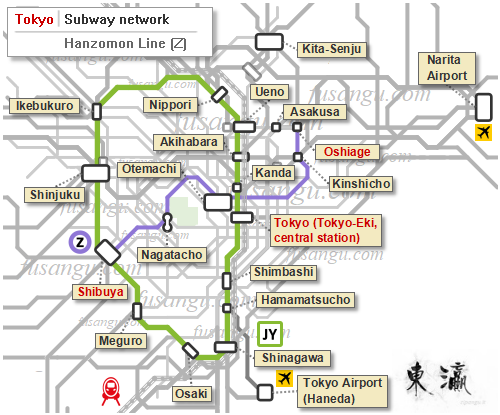
The Hanzomon-sen is one of the most useful lines for those who visit Tokyo for the first time. The line crosses the centre and links major neighbourhoods that are constantly part of the programme of any visit to the city.
In this page we describe a one-day tour along the Hanzomon Line. The article includes a programme that is particularly suitable to those who are in Tokyo for a short period (3-4 days).
Recommended itinerary along the Hanzomon Line
The programme described below covers the whole length of the line, from Sumida to Shibuya. While such an ambitious tour is definitely feasible, we suggest you split the programme in two parts if you wish to enjoy your time and adopt a slower pace. This is the case if you want to visit the numerous museums located near the stations of this line.
Programme:
-
9:00 - 13:00: visit to Sumida. You can begin your tour with a majestic view of Tokyo from the top of the Tokyo Sky Tree observation deck. The tower lies above Oshiage Station, the north-western terminus of the Hanzomon Line. You can then walk to Ryogoku, core of Sumida, an area famous for the presence of numerous traditional sumo schools. Here are many museums such as Edo-Tokyo Museum (excellent introduction to the history of the modern city), the Museum of the Japanese Sword, the Yokoamicho Memorial Park and nearby Great Kanto Earthquake Museum. In spring you ought not to miss a pleasant walk along the Sumida River, one of Tokyo’s most appreciated cherry blossom viewing spots;
-
13:00 - 14:00: lunch break and transfer to Kudanshita Station. You can reach it with the Hanzomon Line leaving from Kinshicho Station;
-
14:00 - 16:00: visit to Yasukuni-Jinja, renowned Shinto shrine where the Japanese people worship the souls of those who gave their life for the nation;
-
16:30 - 20:00: transfer to Shibuya Station. This is the centre of a major entertainment district. If you aim for a more cultural experience, head to Nezu Museum and visit Aoyama Cemetery.
Variants
The Hanzomon Line crosses a few areas of the centre that are usually neglected by first-time visitors, despite being rich in cultural heritage. Among the possible additional destinations, we suggest the following:
-
Kanda, an affluent residential neighbourhood served by Jimbocho Station; here are prestigious universities, bookshops, high-quality shops and some important temples and shrines;
-
Asakusa, historic neighbourhood next to Sumida;
-
Omotesando, a long avenue with many luxury shops and malls.
Transfers
As anticipated, you can follow this programme by making sole use of the Hanzomon Line. Furthermore, the line serves some of the best areas where you can find convenient lodging options.
Main transfers:
-
Oshiage - Kinshicho: 2 minutes | 170 yen
-
Kinshicho - Jimbocho: 16 minutes | 200 yen
-
Jimbocho - Kudanshita: 1 minute | 170 yen
-
Kudanshita - Omote-sando: 9 minutes | 170 yen
For such a programme the available subway day passes (those related to the network operated by Tokyo Metro) do pay off.
Related articles:
Main article: Tokyo 3-day itinerary
Itineraries along the subway lines (Asakusa, Hibiya, Ginza, Marunouchi, Tozai, Mita, Namboku, Yurakucho, Chiyoda, Shinjuku, Hanzomon, Oedo, Fukutoshin)
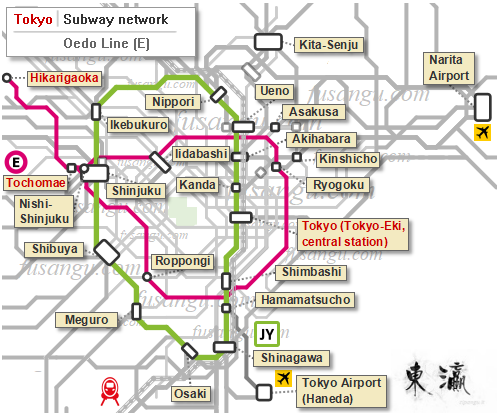
The Oedo-sen is one of the four subway lines managed by Toei, Tokyo’s municipal transportation company.
The long line describes a path in the shape of the number 6. In the centre the line connects some of Tokyo's most popular tourist areas such as Shinjuku, Bunkyo, Ueno, Sumida, Chuo, Minato just to name a few.
In this page we describe a one-day tour along the Oedo Line. The article includes programmes that are suitable for those who are in Tokyo for periods longer than 3-4 days.
If you visit Tokyo for the first time and plan to stay in the city for a short period (3-4 days), you will most likely get around only by making use of the Asakusa, Ginza, Hanzomon, Marunouchi and Fukutoshin subway lines.
Another option, particularly convenient if you travel with a JR Pass, is to use the Yamanote-sen (the loop line) and Chuo-Sobu railway lines.
The above mentioned lines serve all major sightseeing places and tourist areas where you are likely to spend the first week in Tokyo.
If you like venturing out of the typical visiting paths or if you wish to visit less touristy areas, you may find useful to get around with the Oedo Line.
Though technically a circular line like the Yamanote Line, the Oedo Line describes a loop around the centre of Tokyo. Differently from the Yamanote Line, the Oedo Line does link fewer major tourist destinations but is of greater usefulness to those who wish to visit less known neighbourhoods and minor destinations. The line is particularly useful to those who choose to lodge in Shinjuku or Sumida.
Recommended itinerary along the Oedo Line
Below we give brief descriptions of two interesting itineraries along the Oedo Line. The first one is very suitable to those who visit Tokyo for the first time.
From Shinjuku to Sumida through Bunkyo and Asakusa
Below is a programme with starting point in Shinjuku, core of the modern city and major centre of Tokyo’s night life.
Choosing a different sequence of visits poses no difficulty. The programme is very suitable also for those who wish to find accommodation in Asakusa or Sumida, a quiet area full of hostels and cheap hotels.
As a few rides are needed, we suggest you buy a day pass.
The tour starts from Shinjuku-Nishiguchi Station (E01). This is a satellite station located in the area of the main hub of the district, Shinjuku Station.
Programme:
-
8:30 - 10:00: transfer by subway along the Oedo Line between Shinjuku-Nishiguchi Station and Iidabashi Station. You can then reach on foot Koishikawa Koraku-En, one of Tokyo’s main traditional gardens. After the visit (which should last at least half an hour) you can return to Iidabashi Station. In spring you can go past the station until you reach Sotobori Park. This is a pleasant park full of cherry trees;
-
10:00 - 12:00: transfer to Hongo-Sanchome Station. From the station you can walk to Yushima Seido, a confucian temple. This is the first destination to be visited in Kanda, a traditional district rich in cultural heritage and prestigious universities. The next destination can be Kanda Shrine, one of the most popular Shinto shrines of Tokyo. Not far is Origami Kaikan, a small museum devoted to the art of origami;
-
12:00 - 12:30: lunch break;
-
12:30 - 14:00: transfer to Kuramae Station. A 15-minute walk takes you to Senso-Ji, a historic temple and cultural heart of Asakusa, a neighbourhood of the former Shitamachi. The temple is at the centre of a lively area full of souvenir shops, small boutiques and cheap eateries;
-
14:00 - 14:30: a pleasant walk from Asakusa to Ryogoku allows you to go through Sumida Park. This is another major cherry blossom spot;
-
14:30 - 17:30: visit to the Museum of the Japanese Sword or Yokoamicho Memorial Park. History buffs may consider a visit to Edo-Tokyo Museum. Alternatively, if you are interested in Japanese art, you may opt for Sumida Hokusai Museum.
Related articles:
Main article: Tokyo 3-day itinerary
Itineraries along the subway lines (Asakusa, Hibiya, Ginza, Marunouchi, Tozai, Mita, Namboku, Yurakucho, Chiyoda, Shinjuku, Hanzomon, Oedo, Fukutoshin)
Page 3 of 8
